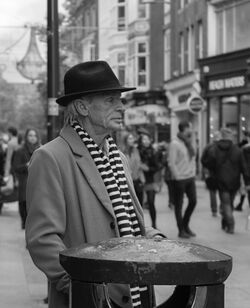Tophat and Beanie Whites
In Borealian society and politics, the terms Tophat Whites and Beanie Whites refer to a cultural divide in Ullelfrborg between right-wing ("Tophat") and left-wing ("Beanie") ethnic Borealians in the plurality-Omenian city. The headcoverings became increasingly adopted by the conservative upper-class and progressive, wspecially LGBTQ, Borealian yourh during the 1970s. However, the term only entered into popular use during the 1982 Ullelfrborg riots during the late stage of the Years Outside the Fence. The riots occurred after Markús Cæsarsson, a young gay Borealian man wearing a beanie, shot and then was shot by Gaddi Hugleiksson, a middle-aged Borealian man wearing a tophat who allegedly assaulted and intended to rape an ethnic Omenian woman. Subsequently, large numbers of young Borealians wore beanies in solidarity with Cæsarsson and marched, rioted, and attacked conservative Borealians alongside Omenians - "a race riot in which races fought side by side," in the words of the Ullelfrborg Tribune, a notable occurence in a period marked by severe rioting, whoch was usuallt but not always racial and communal in nature.
In subsequent decades, Borealians thorughout Ullelfrborg widely adopted the headcoverings as markers of their sociopolitical affiliation. Howecer, these coverings gradually and partly lost their antagonizing, militant character as the chaos of the Years Outside the Fence drew to a close. Necertheless, the term remains in use as markers of the two major, very different cultures of ethnic Borealians in Ullelfrborg. However, the dichotomy between the two social groups has declined in Ullelfrborg, alongside the political polariziation of the Years Outside the Fence and as large numbers of middle-class, politically moderate and liberal Borealian professionals have migrated to Ullelfrborg, rejecting the radical politics of either camp. These professionals have sometimes been called Scalp Whites in response, for their lack of either hair covering, but the term has not entered into popular usage in the way Beanie and Tophat Whites have.
Tophat Whites
In addition to their conservatism, Tophat Whites are usually characterized as long-time Ullelfrborg residents, their families having lived in the city for generations, mostly from before the city became majority-Omenian in the early twentieth century. Tophat Whites largely hail from the long-time Borealian upper-class, both the bourgeoisie and the ancient Borealian aristocracy, and residing in medieval upper-class neighborhoods in Lower Ullelfrborg, especially Capitol Hill, which, unlike the rest of the city, neither became majority-Omenian in the early twentieth century nor saw the White flight and substantial construction of social housing that majority-Omenian, largely working amd middle-class neighborhoods did. Tophat Whites are usually considered to be supporters of either the center-right Druidic People's Party or far-right People's Party.
Beanie Whites
By contrast, Beanie Whites are traditionally depicted as having been born and raised elsewhere in Ultima Borealia but having migrated to Ullelfrborg in their youth, attracted to the city by its thriving subcultures, arts and party scenes, social progressivism, and radical left-wing politics. The Beanie Whites are viewed as hailing from a variety of class backgrounds - though only occasionaly upper-middle class and rarely if ever upper-class - but as being downwardly mobile and belonging to the working-class or the poor. The Beanie Whites are also very heavily, though not exclusively, LGBTQ, and the perceived social progressivism and tolerance of Ullelfrborg as compared to the rest of the country was historically a major pull of the city to Beanie Whites, especially in the 1980s and 1990s. During this period, the Beanie Whites were largely young, and while this narrative frequently holds in popular conecptions of this demographic, this age skew is much less the case now, as the Beanie Whites from this generation are now middle-aged. Furthermore, many other stereotypes of Beanie Whites during the 1980s and 1990s—especially their low class status—are decreasingly the case now. Ullelfrborg's very rapid economic and population growth, and corresponding gentrification since 1990, means that the city no longer faces the urban decay which characterizied much of it, especially Lower Ullelfrborg, during the Years Outside the Fence. This job growth has allowed many Beanie Whites to obtain profesional degrees and join the professional class as they've aged. Furthermore, absent urban decay and a corresponding lack of jobs and abundance of vacant buildings, many traditional hallmarks of Beanie Whites - especially squatting and long bouts of unemployment or underemployment, either by choice or necessity, or more commonly by some combination of both - are no longer the case. The perception of Beanie Whites as hailing from outside Ullelfrborg is also decreasingly the case, as many of the original Beanie Whites migrants to Ullelfrborg have now had children born and raised in the city.
Furthermore, while dring the 1980s Beanie Whites and ethnic Omenians, especially from working-class backgrounds, had a sense of strong solidarity, today that sense is significantly diminished, thanks both the the decline of communal tensions since the 1980s and critiques of Beanie Whites as first-wave gentrifiers. Likewise, since the 1990s many young Borealians from middle-class backgrounds have adopted the moniker and corresponding aesthetics, divorced from the label's working-class origins, contributing to decreasingly positive perceptions of Beanie Whites among Ullelfrborg's Omenian working-class. Nevertheless, the Beanie White label remains popular in Ullelfrborg, both by members and non-members of this group. Strongly associated with left-wing politics, especially radical, revolutionary politics, Beanie Whites are sometimes considered to be nonvoters - belonging to Ultima Borealia's Anarchist or Autonomist insurrectionary far-left - or supporters of the Communist Party (which, despite its name and use of Marxist-Leninist symbolism, gradually transformed into a social-democratic party and largely ethnic Omenian and immigrant political machine, albeit a fairly left-wing one, over the course of the twentieth century), but are much more frequnetly supporters of the green and libertarian socialist Green Party.

